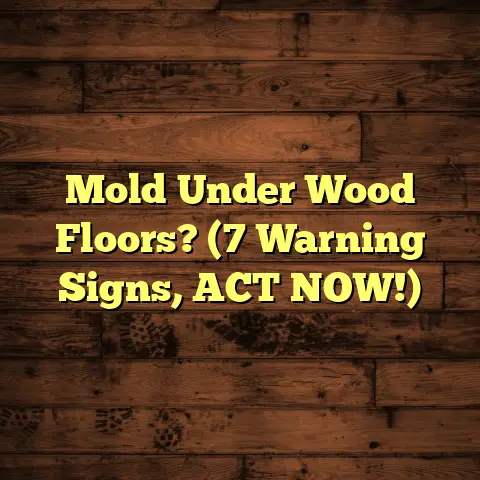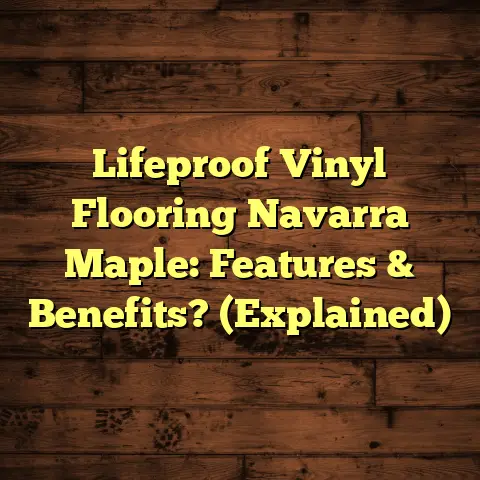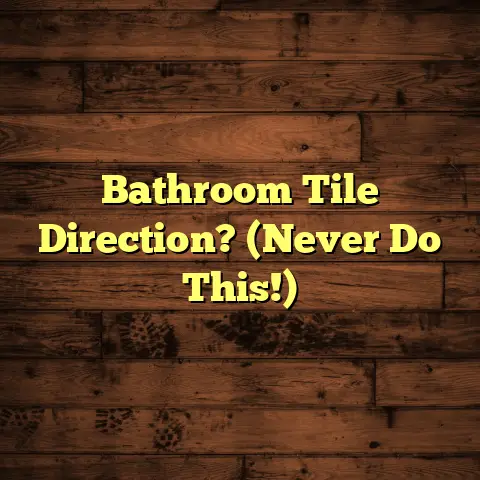Fix Squeaky Wood Floors? (5 Pro Secrets!)
Ever notice how much more you enjoy tinkering in your workshop or losing yourself in a good book when your home is peaceful? I’ve found that a comfortable living space really amps up the joy I get from my hobbies.
But what about those pesky squeaky wood floors?
They can turn a relaxing afternoon into an annoying symphony of creaks and groans. Trust me, as a flooring contractor for over 15 years, I’ve heard my fair share of squeaky floor complaints!
The good news is, you don’t have to live with it. I’m going to let you in on some pro secrets that can help you silence those squeaks and reclaim your peaceful haven. Let’s get started!
Section 1: Understanding Squeaky Wood Floors
So, what exactly are squeaky wood floors?
Simply put, it’s that irritating noise your floor makes when you walk on it. It’s usually caused by friction – wood rubbing against wood or nails.
Common Culprits:
- Moisture: Wood expands when it’s humid and contracts when it’s dry. This movement can loosen fasteners and create friction points.
- Temperature Changes: Similar to moisture, temperature fluctuations cause the wood to move, leading to squeaks.
- Loose Floorboards: Over time, the nails or screws holding your floorboards in place can loosen, allowing the boards to rub against each other or the subfloor.
Think of it like this: your wood floor is a living, breathing thing. It responds to its environment.
The Mechanics of Wood Flooring
Wood flooring, whether solid hardwood or engineered wood, is susceptible to changes in humidity and temperature. The wood fibers expand when they absorb moisture and contract when they dry out.
Did you know that wood can expand and contract differently depending on the type of wood? Some woods are more stable than others, meaning they are less prone to movement due to changes in humidity and temperature.
Ignoring the Squeak: A Recipe for Disaster?
While a squeaky floor might seem like a minor annoyance, ignoring it can lead to bigger problems down the road.
- Further Damage: Constant friction can wear down the wood, leading to splintering or cracking.
- Loose Fasteners: The squeaking indicates that fasteners are already loose. Ignoring it can cause them to become even looser, potentially leading to more significant repairs.
- Subfloor Issues: In some cases, the squeak might be a sign of a problem with the subfloor, such as rot or water damage.
Think of it like a loose tooth. Ignoring it won’t make it go away; it’ll just get worse!
Section 2: Pro Secret #1 – The Talcum Powder Trick
Okay, let’s get to our first pro secret!
This one’s a classic and often works wonders for minor squeaks.
The Talcum Powder Magic
Talcum powder acts as a dry lubricant, reducing friction between floorboards. It’s especially effective when the squeak is caused by slight movement between boards.
Step-by-Step Guide:
- Identify the Squeak: Walk around the room and pinpoint the exact location of the squeak.
- Apply the Powder: Sprinkle a generous amount of talcum powder directly over the squeaky area.
- Work It In: Use a soft brush or your fingers to gently work the powder into the cracks between the floorboards.
- Clean Up: Wipe away any excess powder with a damp cloth.
Tools & Materials:
- Talcum powder (unscented is best to avoid lingering smells)
- Soft brush
- Damp cloth
Pro Tip:
For deeper cracks, use a small squeeze bottle to apply the powder more precisely.
Avoiding the Mess:
- Use a vacuum cleaner with a brush attachment to clean up any spilled powder.
- Avoid using too much powder, as it can leave a residue.
- Test the powder in an inconspicuous area first to ensure it doesn’t stain your flooring.
I’ve seen this simple trick solve so many squeak problems. It’s a great first step before moving on to more involved solutions.
Section 3: Pro Secret #2 – Squeak-Relief Kit
Ready for the next level? Let’s talk about a squeak-relief kit!
What’s in the Kit?
A squeak-relief kit is your arsenal for tackling more stubborn squeaks. It typically includes:
- Screws: For securing loose floorboards to the joists.
- Wood Glue: To bond loose boards together.
- Shims: Thin pieces of wood used to fill gaps and provide support.
- Drill: For pre-drilling pilot holes for screws.
- Wood Putty: To fill in screw holes or gaps.
Building Your Kit:
You can easily assemble your own kit with items from your local hardware store. I recommend having a variety of screw sizes and shim thicknesses on hand.
When to Use Each Component:
- Screws: Use screws when the floorboard is loose from the joist.
- Wood Glue: Use wood glue to bond loose boards together, especially along the edges.
- Shims: Use shims to fill gaps between the floorboard and the subfloor or joist.
- Wood Putty: Use wood putty to fill in any screw holes or gaps after the repair is complete.
The Process (Step-by-Step):
- Locate the Squeak: Identify the exact location of the squeak.
- Assess the Situation: Determine the cause of the squeak. Is the board loose from the joist? Is there a gap between the board and the subfloor?
- Choose Your Weapon: Select the appropriate component from your kit based on the assessment.
- Apply the Fix:
- Screws: Pre-drill a pilot hole through the floorboard and into the joist. Then, drive the screw in until it’s snug but not overtightened.
- Wood Glue: Apply a thin bead of wood glue to the edges of the loose boards. Then, press the boards together and hold them in place with weights or clamps until the glue dries.
- Shims: Gently tap the shim into the gap between the floorboard and the subfloor or joist. Be careful not to overtighten, as this can cause the floorboard to buckle.
- Clean Up: Wipe away any excess glue or wood putty.
Addressing Different Scenarios:
- Between Floorboards: Use wood glue and clamps to bond the boards together.
- Along the Joists: Use screws to secure the floorboard to the joist.
- Gaps Between Subfloor and Floorboards: Use shims to fill the gaps and provide support.
I find a squeak-relief kit to be an invaluable tool for any homeowner. It allows you to address a wide range of squeak problems with ease.
Section 4: Pro Secret #3 – The Dry Lubricant Method
Now, let’s explore the magic of dry lubricants!
Why Dry Lubricants?
Dry lubricants, like graphite powder or silicone spray, are excellent for reducing friction without attracting dust or dirt. This is crucial for maintaining a clean and healthy home environment.
How to Apply:
- Identify the Squeak: Pinpoint the exact location of the squeak.
- Prepare the Area: Clean the area around the squeak with a damp cloth.
- Apply the Lubricant:
- Graphite Powder: Use a small squeeze bottle or applicator to puff the powder into the cracks between the floorboards.
- Silicone Spray: Use the spray nozzle to direct the lubricant into the cracks.
- Work It In: Use a soft brush or your fingers to gently work the lubricant into the cracks.
- Clean Up: Wipe away any excess lubricant with a clean cloth.
Safety First!
- Ventilation: Ensure proper ventilation when using silicone spray, as it can have a strong odor.
- Eye Protection: Wear safety glasses to protect your eyes from the lubricant.
- Flammability: Be aware of the flammability of some lubricants and keep them away from open flames.
Best Practices:
- Use Sparingly: A little goes a long way. Avoid over-applying the lubricant, as it can leave a residue.
- Test First: Test the lubricant in an inconspicuous area first to ensure it doesn’t damage your flooring.
- Reapply as Needed: Dry lubricants can wear off over time, so you may need to reapply them periodically.
I’ve found that dry lubricants are especially effective for squeaks caused by slight movement between floorboards. They’re a clean and easy solution that can provide long-lasting relief.
Section 5: Pro Secret #4 – The Shim Technique
Let’s talk about shims – the unsung heroes of floor repair!
What are Shims?
Shims are thin, tapered pieces of wood used to fill gaps and provide support. They’re essential for fixing squeaks caused by uneven subfloors or loose joists.
Finding the Shim Spot:
- Locate the Squeak: Identify the exact location of the squeak.
- Inspect the Area: Examine the area around the squeak to determine the cause. Is there a gap between the floorboard and the subfloor or joist?
- Test for Movement: Gently press down on the floorboard to see if it moves. If it does, it likely needs shimming.
The Shim Insertion Tutorial:
- Prepare the Shim: Cut the shim to the appropriate length and shape.
- Apply Wood Glue: Apply a thin layer of wood glue to the shim.
- Insert the Shim: Gently tap the shim into the gap between the floorboard and the subfloor or joist.
- Trim the Excess: Use a utility knife or saw to trim any excess shim material.
- Clean Up: Wipe away any excess glue.
The Delicate Touch:
- Avoid Over-Tightening: Be careful not to overtighten the shim, as this can cause the floorboard to buckle.
- Use the Right Size Shim: Use a shim that is just the right thickness to fill the gap.
- Test the Repair: After inserting the shim, walk over the area to see if the squeak is gone.
Important Note: This technique can be tricky, and you need to be very careful to avoid damaging the flooring. If you’re not comfortable with this process, it’s best to call a professional.
I’ve used shims countless times to fix squeaky floors. They’re a simple but effective solution for providing support and eliminating movement.
Section 6: Pro Secret #5 – Professional Help
Sometimes, DIY just isn’t enough. Let’s talk about when to call in the pros.
When to Call a Pro:
- Extensive Squeaking: If the squeaking is widespread and you’ve tried the DIY solutions without success.
- Subfloor Damage: If you suspect there’s damage to the subfloor, such as rot or water damage.
- Unsure of the Cause: If you’re unable to determine the cause of the squeak.
- Lack of Experience: If you’re not comfortable working with power tools or don’t have experience with home repairs.
Finding the Right Expert:
- Check Credentials: Look for a flooring contractor with a valid license and insurance.
- Read Reviews: Check online reviews and testimonials to see what other customers have to say.
- Get Referrals: Ask friends, family, or neighbors for referrals.
Questions to Ask:
- Experience: How many years of experience do you have repairing squeaky floors?
- Method: What method do you recommend for fixing my squeaky floors?
- Warranty: Do you offer a warranty on your work?
- Cost: What is the estimated cost of the repair?
Real-Life Success Stories:
I remember one client who had tried everything to fix their squeaky floors. They were at their wit’s end! After inspecting the floors, I discovered that the subfloor was damaged due to a hidden water leak. We replaced the damaged subfloor and installed new flooring. The client was thrilled with the results and finally had a quiet, peaceful home.
Another time, a client had squeaky floors in their historic home. They were concerned about damaging the original flooring. We carefully removed the floorboards, repaired the underlying joists, and reinstalled the original flooring. The client was delighted that we were able to preserve the character of their home while eliminating the squeaks.
Don’t hesitate to call a professional when you’re in over your head. A qualified flooring contractor can diagnose the problem and provide a solution that will last for years to come.
Conclusion: Bringing It All Together
So, there you have it! Five pro secrets to help you silence those squeaky wood floors and reclaim your peaceful haven.
Remember, a quiet, well-maintained home can significantly enhance your enjoyment of hobbies. Whether you’re crafting, woodworking, or simply relaxing, a squeak-free environment can make all the difference.
Don’t be afraid to try the DIY solutions outlined in this article. You might be surprised at how much you can accomplish on your own. And who knows, fixing those squeaky floors might just inspire you to tackle other home improvement projects!
I hope this article has been helpful. Now go forth and conquer those squeaks! Your hobbies (and your sanity) will thank you for it.





